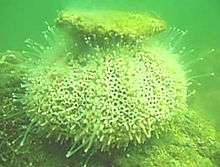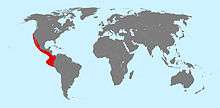Toxopneustes roseus
Toxopneustes roseus is a species of sea urchin from the East Pacific. It is sometimes known as the rose flower urchin or the pink flower urchin. Like the related flower urchin, they are venomous.
| Toxopneustes roseus | |
|---|---|
 | |
| Male Toxopneustes roseus from the Gulf of California releasing milt (see video here). The object on top of the animal is a piece of coral rubble. | |
| Scientific classification | |
| Kingdom: | |
| Phylum: | |
| Class: | |
| Superorder: | |
| Order: | |
| Infraorder: | |
| Family: | |
| Genus: | |
| Species: | T. roseus |
| Binomial name | |
| Toxopneustes roseus (A. Agassiz, 1863) | |
 | |
Estimated range | |
| Synonyms[1] | |
| |
Taxonomy
Toxopneustes roseus is one of the four species in the genus Toxopneustes. It was first described by the American zoologist Alexander Emanuel Agassiz in 1863 as Boletia roseus.[1]
The generic name Toxopneustes literally means "poison breath", derived from Greek τοξικόν [φάρμακον] (toksikón [phármakon], "arrow [poison]") and πνευστος (pneustos, "breath"). The specific name roseus means "rosy" in Latin.
Though it does not have a widely used common name, it is sometimes known as the "rose flower urchin" or the "pink flower urchin".[2] More commonly, it is simply called a "flower urchin", though that name strictly applies only to the related Indo-West Pacific species, Toxopneustes pileolus.
Description
Toxopneustes roseus is similar in appearance to the more widespread flower urchin, Toxopneustes pileolus. It can be distinguished by having a rigid "shell" (test) that is a solid pink, red, or purple in color, in contrast to the variegated coloration of the test of Toxopneustes pileolus.[3][4] Like other members of the genus, its most conspicuous feature are its numerous pedicellariae (stalked grasping appendages) which gives it the appearance of being a cluster of flowers.[5]
Distribution
Toxopneustes roseus is the only member of the genus found in the East Pacific. It can be found from Peru, up along the coast of Central America (including the Gulf of California), and as far north as California. They can also be found in the waters around the Galapagos Islands.[1][6][7]
They are common in coral reefs, rhodolith beds, and rocky environments,[6] at depths of 2 to 50 m (7 to 164 ft).[7][8] They can also be found in sand and mud substrates.[5]
Ecology
Toxopneustes roseus feeds almost exclusively on rhodoliths, a coralline algae. They are highly mobile. They move and feed throughout the day and night, though they seem to be more active at night.[6]
Toxopneustes roseus are among the numerous species of sea urchins known as "collector urchins", so named because they frequently cover the upper surfaces of their bodies with debris from their surroundings. This behavior is usually referred to as "covering" or "heaping".[9][10] A 1998 study has postulated that the debris collected by the sea urchins may serve as ballast, preventing them from being swept away by wave surges when feeding[6]
Venom
Like other members of the genus, Toxopneustes roseus is venomous. The flower-like pedicellariae can deliver a painful sting if touched.[5]
See also
References
- Andreas Kroh (2014). Kroh A, Mooi R (eds.). "Toxopneustes roseus (A. Agassiz, 1863)". World Echinoidea Database. World Register of Marine Species. Retrieved November 22, 2014.
- "Commonly Seen Marine Creatures". Galapagos Diving. September 4, 2014. Retrieved November 25, 2014.
- Hubert Lyman Clark (1925). A Catalogue of the Recent Sea-Urchins (Echinoidea) in the Collection of the British Museum (Natural History). Oxford University Press. pp. 122–123.
- Alexander Agassiz & Hubert Lyman Clark (1912). "Hawaiian and Other Pacific Echini: The Pedinidae, Phymosomatidae, Stomopneustidae, Echinidae, Temnopleuridae, Strongylocentrotidae, and Echinometridae". Memoirs of the Museum of Comparative Zoölogy at Harvard College. 34 (4): 207–383.
- "'Flower Sea Urchin - Erizo Florado (Toxopneustes roseus)". MexFish. Retrieved November 25, 2014.
- David Wayland James (1998). The Biology of Toxopneustes roseus in Rhodolith Beds in Baja California Sur, Mexico (PDF) (M.Sc.). San Jose State University.
- Simon Coppard. "Toxopneustes roseus". Encyclopedia of Life. Retrieved November 25, 2014.
- The Echinoid Directory. "Toxopneustes L. Agassiz, 1841, p. 7". Natural History Museum. Retrieved November 25, 2014.
- Christopher Mah (February 4, 2014). "What we know about the world's most venomous sea urchin Toxopneustes fits in this blog post!". Echinoblog. Retrieved November 22, 2014.
- Yasunobu Yanagisawa (1972). "Preliminary observations on the so-called heaping behaviour in a sea urchin, Hemicentrotus pulcherrimus (A. Agassiz)" (PDF). Publications of the Seto Marine Biological Laboratory. 9 (6): 431–435.
External links
- Photos of Toxopneustes roseus on Sealife Collection